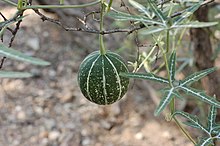| Cucurbita digitata | |
|---|---|

| |
| Conservation status | |
 Least Concern (IUCN 3.1) | |
| Scientific classification | |
| Kingdom: | Plantae |
| Clade: | Tracheophytes |
| Clade: | Angiosperms |
| Clade: | Eudicots |
| Clade: | Rosids |
| Order: | Cucurbitales |
| Family: | Cucurbitaceae |
| Genus: | Cucurbita |
| Species: | C. digitata |
| Binomial name | |
| Cucurbita digitata Gray | |
Cucurbita digitata is a species of flowering plant in the squash family known by the common names fingerleaf gourd and bitter squash. It is similar to Cucurbita californica, Cucurbita cordata, Cucurbita cylindrata, and Cucurbita palmata and all these species hybridize readily. These species form the only restricted xerophyte species group in the genus Cucurbita. Each member of this species group is native to the Southwestern United States and Northwestern Mexico where they are relatively uncommon. Each group member is found in hot, arid regions with low rainfall. They prefer soil that is loose, gravelly, and well-drained. C. digitata is native to northern Baja California at higher elevations, northern Sonora, Mexico, southern Arizona, and southwestern New Mexico. The juvenile leaves of C. cylindrata, C. cordata, C. digitata, and C. palmata show a high degree of similarity, but their mature leaves are visibly different, as are their root structures. C. palmata and C. digitata are sympatric, with C. palmata separating the ranges of C. digitata at the juncture of Baja California, California, and Arizona. C. digitata fruits are clear green mottle that turns yellow at maturity, striped, and round.
It was first identified by Asa Gray in 1853.
Description
Cucurbita digitata is a hairy vining plant with sharply palmate leaves having five fingerlike lobes. It is quite similar in appearance to its close relative, the coyote gourd Cucurbita palmata, but the lobes of its leaves are usually more slender.
It has curling yellow flowers up to 5 centimeters wide.
The fruit is a dark green squash, rounded or nearly rounded, with mottling and distinct white stripes. The bitter fruit is very distasteful and generally not edible, although a few animals may hesitantly eat the flesh while trying to get at the seeds. Each white seed is about a centimeter long and at 35% protein and 50% fat is a nutritious food.
References
- Sánchez de la Vega, G., Contreras, A., Aragón Cuevas, F. & Lira Saade, R. 2020. Cucurbita digitata (amended version of 2019 assessment). The IUCN Red List of Threatened Species 2020: e.T109928565A173923857. https://dx.doi.org/10.2305/IUCN.UK.2020-2.RLTS.T109928565A173923857.en. Downloaded on 24 September 2021.
- Puchalski, J. T.; Robinson, R. W. (1978). "Comparative Electrophoretic Analysis of Isozymes in Cucurbita Species". Cucurbit Genetics Cooperative Report. 1. Raleigh, NC: North Carolina State University: 28.
- Bemis, W. P.; Whitaker, Thomas W. (April 1969). "The Xerophytic Cucurbita of Northwestern Mexico and Southwestern United States". Madroño. 20 (2). California Botanical Society: 33–41. JSTOR 41423342.
- Nee, Michael (1990). "The Domestication of Cucurbita (Cucurbitaceae)". Economic Botany. 44 (3, Supplement: New Perspectives on the Origin and Evolution of New World Domesticated Plants). New York: New York Botanical Gardens Press: 56–68. Bibcode:1990EcBot..44S..56N. doi:10.1007/BF02860475. JSTOR 4255271. S2CID 40493539.
External links
| Cucurbita | |||||||
|---|---|---|---|---|---|---|---|
| List of gourds and squashes | |||||||
| Species |  | ||||||
| Cultivars |
| ||||||
| Related topics |
| ||||||
| Taxon identifiers | |
|---|---|
| Cucurbita digitata |
|
- IUCN Red List least concern species
- Cucurbita
- Vines
- Flora of Northwestern Mexico
- Flora of the Southwestern United States
- Flora of California
- Flora of Sonora
- Flora of the Sonoran Deserts
- North American desert flora
- Flora of the California desert regions
- Natural history of the Peninsular Ranges
- Plants described in 1853
- Taxa named by Asa Gray
- Squashes and pumpkins